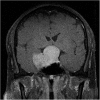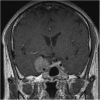Prediction of Long-term Post-operative Testosterone Replacement Requirement Based on the Pre-operative Tumor Volume and Testosterone Level in Pituitary Macroadenoma
- PMID: 26537232
- PMCID: PMC5155724
- DOI: 10.1038/srep16194
Prediction of Long-term Post-operative Testosterone Replacement Requirement Based on the Pre-operative Tumor Volume and Testosterone Level in Pituitary Macroadenoma
Abstract
Non-functioning pituitary macroadenomas (NFPAs) are the most prevalent pituitary macroadenomas. One common symptom of NFPA is hypogonadism, which may require long-term hormone replacement. This study was designed to clarify the association between the pre-operative tumor volume, pre-operative testosterone level, intraoperative resection status and the need of long-term post-operative testosterone replacement. Between 2004 and 2012, 45 male patients with NFPAs were enrolled in this prospective study. All patients underwent transsphenoidal surgery. Hypogonadism was defined as total serum testosterone levels of <2.4 ng/mL. The tumor volume was calculated based on the pre- and post-operative magnetic resonance images. We prescribed testosterone to patients with defined hypogonadism or clinical symptoms of hypogonadism. Hormone replacement for longer than 1 year was considered as long-term therapy. The need for long-term post-operative testosterone replacement was significantly associated with larger pre-operative tumor volume (p = 0.0067), and lower pre-operative testosterone level (p = 0.0101). There was no significant difference between the gross total tumor resection and subtotal resection groups (p = 0.1059). The pre-operative tumor volume and testosterone level impact post-operative hypogonadism. By measuring the tumor volume and the testosterone level and by performing adequate tumor resection, surgeons will be able to predict post-operative hypogonadism and the need for long-term hormone replacement.
Figures



Similar articles
-
Anemia, testosterone, and pituitary adenoma in men.J Neurosurg. 2003 May;98(5):974-7. doi: 10.3171/jns.2003.98.5.0974. J Neurosurg. 2003. PMID: 12744356
-
Magnetic resonance imaging after transsphenoidal surgery of clinically non-functional pituitary macroadenomas and its impact on detecting residual adenoma.Acta Neurochir (Wien). 2002 May;144(5):433-43. doi: 10.1007/s007010200064. Acta Neurochir (Wien). 2002. PMID: 12111499
-
Optimal diagnostic measures and thresholds for hypogonadism in men with HIV/AIDS: comparison between 2 transdermal testosterone replacement therapy gels.Postgrad Med. 2013 Mar;125(2):30-9. doi: 10.3810/pgm.2013.03.2639. Postgrad Med. 2013. PMID: 23816769
-
Late-Onset Hypogonadism and Testosterone Replacement in Older Men.Clin Geriatr Med. 2015 Nov;31(4):631-44. doi: 10.1016/j.cger.2015.07.001. Clin Geriatr Med. 2015. PMID: 26476121 Review.
-
Testosterone replacement-induced hyperprolactinaemia: case report and review of the literature.Ann Clin Biochem. 2005 Mar;42(Pt 2):153-9. doi: 10.1258/0004563053492784. Ann Clin Biochem. 2005. PMID: 15829128 Review.
Cited by
-
Pituitary adenoma consistency affects postoperative hormone function: a retrospective study.BMC Endocr Disord. 2023 Apr 26;23(1):92. doi: 10.1186/s12902-023-01334-1. BMC Endocr Disord. 2023. PMID: 37101307 Free PMC article.
-
Magnetic resonance imaging characteristics predict pituitary function in non-functional pituitary macro-adenoma undergoing trans-sphenoidal surgery.BMC Med Imaging. 2022 Apr 1;22(1):60. doi: 10.1186/s12880-022-00787-5. BMC Med Imaging. 2022. PMID: 35365091 Free PMC article.
-
Delayed Puberty-Phenotypic Diversity, Molecular Genetic Mechanisms, and Recent Discoveries.Endocr Rev. 2019 Oct 1;40(5):1285-1317. doi: 10.1210/er.2018-00248. Endocr Rev. 2019. PMID: 31220230 Free PMC article. Review.
References
-
- Dekkers O. M. et al. Observation alone after transsphenoidal surgery for nonfunctioning pituitary macroadenoma. J Clin Endocrinol Metab. 91, 1796–1801 (2006). - PubMed
-
- Wichers R. M., Hoven S., Kristof R. A., Bliesener N. & Stoffel W. B. Non-functioning pituitary adenomas: endocrinological and clinical outcome after transsphenoidal and transcranial surgery. Exp Clin Endocrinol Diabetes. 112, 323–327 (2004). - PubMed
-
- Alameda C. et al. Experience in management of 51 non-functioning pituitary adenomas: indications for post-operative radiotherapy. J Endocrinol Invest. 28, 18 –22 (2005). - PubMed
-
- Marazuela M. et al. Recovery of visual and endocrine function following transsphenoidal surgery of large nonfunctioning pituitary adenomas. J Endocrinol Invest. 17, 703–707 (1994). - PubMed
-
- Nomikos P., Buchfelder M. & Fahlbusch R. The outcome of surgery in 668 patients with acromegaly using current criteria of biochemical ‘cure’. Eur J Endocrinol. 152, 379–387 (2005). - PubMed
Publication types
MeSH terms
Substances
LinkOut - more resources
Full Text Sources
Other Literature Sources
Medical

